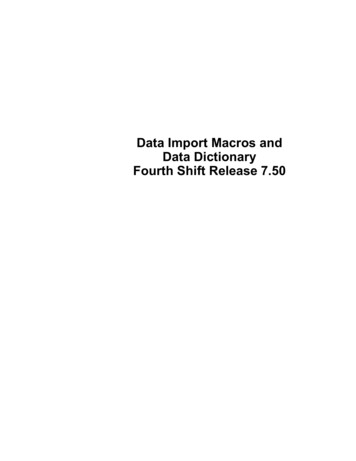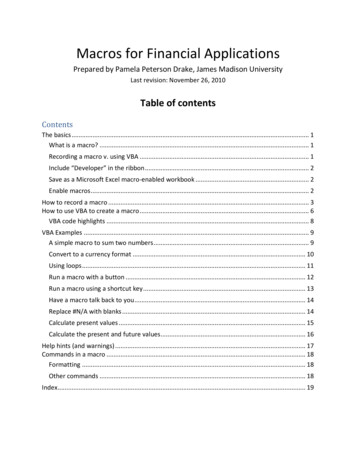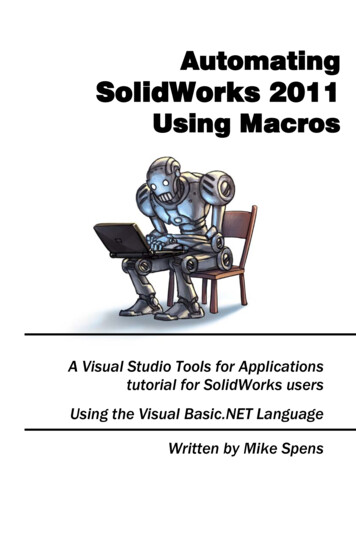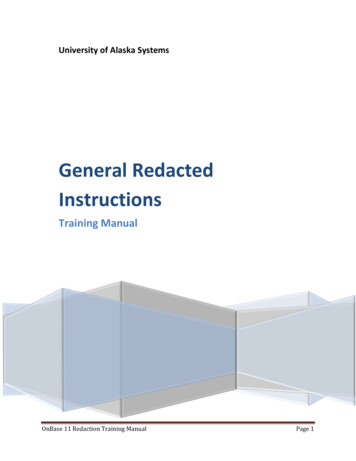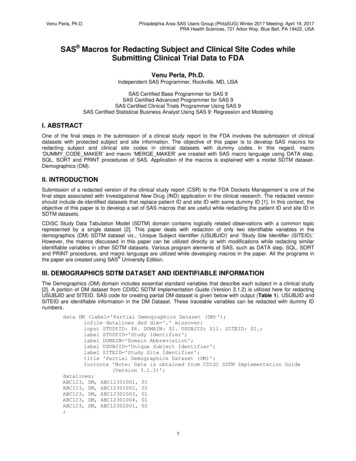
Transcription
Venu Perla, Ph.D.Philadelphia Area SAS Users Group (PhilaSUG) Winter 2017 Meeting; April 19, 2017PRA Health Sciences, 721 Arbor Way, Blue Bell, PA 19422, USASAS Macros for Redacting Subject and Clinical Site Codes whileSubmitting Clinical Trial Data to FDAVenu Perla, Ph.D.Independent SAS Programmer, Rockville, MD, USASAS Certified Base Programmer for SAS 9SAS Certified Advanced Programmer for SAS 9SAS Certified Clinical Trials Programmer Using SAS 9SAS Certified Statistical Business Analyst Using SAS 9: Regression and ModelingI. ABSTRACTOne of the final steps in the submission of a clinical study report to the FDA involves the submission of clinicaldatasets with protected subject and site information. The objective of this paper is to develop SAS macros forredacting subject and clinical site codes in clinical datasets with dummy codes. In this regard, macro‘DUMMY CODE MAKER’ and macro ‘MERGE MAKER’ are created with SAS macro language using DATA step,SQL, SORT and PRINT procedures of SAS. Application of the macros is explained with a model SDTM datasetDemographics (DM).II. INTRODUCTIONSubmission of a redacted version of the clinical study report (CSR) to the FDA Dockets Management is one of thefinal steps associated with Investigational New Drug (IND) application in the clinical research. The redacted versionshould include de-identified datasets that replace patient ID and site ID with some dummy ID [1]. In this context, theobjective of this paper is to develop a set of SAS macros that are useful while redacting the patient ID and site ID inSDTM datasets.CDISC Study Data Tabulation Model (SDTM) domain contains logically related observations with a common topicrepresented by a single dataset [2]. This paper deals with redaction of only two identifiable variables in thedemographics (DM) SDTM dataset viz., ‘Unique Subject Identifier (USUBJID)’ and ‘Study Site Identifier (SITEID).’However, the macros discussed in this paper can be utilized directly or with modifications while redacting similaridentifiable variables in other SDTM datasets. Various program elements of SAS, such as DATA step, SQL, SORTand PRINT procedures, and macro language are utilized while developing macros in the paper. All the programs in the paper are created using SAS University Edition.III. DEMOGRAPHICS SDTM DATASET AND IDENTIFIABLE INFORMATIONThe Demographics (DM) domain includes essential standard variables that describe each subject in a clinical study[2]. A portion of DM dataset from CDISC SDTM Implementation Guide (Version 3.1.2) is utilized here for redactingUSUBJID and SITEID. SAS code for creating partial DM dataset is given below with output (Table 1). USUBJID andSITEID are identifiable information in the DM Dataset. These traceable variables can be redacted with dummy IDnumbers.data DM (label 'Partial Demographics Dataset (DM)');infile datalines dsd dlm ',' missover;input STUDYID: 6. DOMAIN: 2. USUBJID: 11. SITEID: 2.;label STUDYID 'Study Identifier';label DOMAIN 'Domain Abbreviation';label USUBJID 'Unique Subject Identifier';label SITEID 'Study Site Identifier';title 'Partial Demographics Dataset (DM)';footnote 'Note: Data is obtained from CDISC SDTM Implementation Guide(Version 3.1.2)';datalines;ABC123, DM, ABC12301001, 01ABC123, DM, ABC12301002, 01ABC123, DM, ABC12301003, 01ABC123, DM, ABC12301004, 01ABC123, DM, ABC12302001, 02;1
Venu Perla, Ph.D.Philadelphia Area SAS Users Group (PhilaSUG) Winter 2017 Meeting; April 19, 2017PRA Health Sciences, 721 Arbor Way, Blue Bell, PA 19422, USArun;proc print data DM; run;title;footnote;Table 1. Partial Demographics Dataset (DM)IV. REDACTION OF SITEID AND USUBJIDA. MACRO ‘DUMMY CODE MAKER’The objective, description of macro parameters and SAS code for the macro ‘DUMMY CODE MAKER,’ areexplained below. This macro is utilized for redacting SITEID and *****************************Macro: DUMMY CODE MAKER.SASObjective: To recode identifiable variable IDs withreproducible random integer numbers.Author: Venu PerlaDate: January 29, 2017SAS version: SAS University ---------------------------MACRO PARAMETERSmin: Lower integer value to be considered for randomnumbers.max: Upper integer value to be considered for randomnumbers.Note: Consider higher digit values (example: 11111)for 'min' and 'max' to avoid generation of duplicatevalues.datset: Input dataset in which identifiable variable is present.ivar: Identifiable variable in 'datset'.redvar: Redacted name for 'ivar'. Contains new integer numbers.redset: Output dataset with 'redvar' and other requiredvariables.keep2: List of variables to be kept in output dataset(blank separated).redlabel: Label for redacted variable *****************************/%macro dummy code maker (ivar , datset , min , max , redvar , redset , keep2 ,redlabel );%local ivar datset min max redvar redset keep2 totaln redlabel;%*sorting identifiable variable without duplicate values;proc sort data &datset out &datset. nodupkey;by &ivar;run;2
Venu Perla, Ph.D.Philadelphia Area SAS Users Group (PhilaSUG) Winter 2017 Meeting; April 19, 2017PRA Health Sciences, 721 Arbor Way, Blue Bell, PA 19422, USA%*A macro variable for total number of observations in the identifiablevariable;proc sql noprint;select count (distinct &ivar) into: totalnfrom &datset. ;quit;%put Total number of observations in &ivar &totaln;%*A macro for generating random integers between MIN and MAX values [SeeReference 3];%macro RandBetween(min , max );(&min floor((1 &max-&min)*rand("uniform")))%mend RandBetween;%*Generation of reproducible random integers between MIN and MAX valueswith a fixed seeding value of 123;data rd (drop i);call streaminit(123);do i 1 to &totaln;&redvar %RandBetween(min &min, max &max);output;end;run;%*Sorting random numbers and eliminating duplicate values. If duplicatevalues are found in output, rerun the program afterincreasing MIN and MAX value digits (example: 111 to 1111);proc sort data rd out rd nodupkey;by &redvar;run;%*Concatenating DATSET with RANDOM dataset;%*Output dataset with redacted REDVAR and required variables;data &redset (keep &keep2);merge &datset. rd;label &redvar. "&redlabel";run;%*Printing output;proc print data &redset;run;%mend dummy code ***************************/*Examples for invoking macro DUMMY CODE MAKER;*%dummy code maker (ivar USUBJID, datset DM, min 111, max 999, redvar USUBJNM,redset DM1, keep2 USUBJID USUBJNM, redlabel Unique SubjectIdentifier (Redacted));B. MACRO ‘MERGE MAKER’The objectives, description of macro parameters and SAS code for the macro ‘MERGE MAKER,’ are explainedbelow. This macro is utilized for redacting SITEID and *****************************Macro: MERGE MAKER.SASObjective: 1. To merge two datasets.2. Optionally, to keep &/or drop certain variables in themerged dataset.Author: Venu PerlaDate: January 29, 20173
Venu Perla, Ph.D.Philadelphia Area SAS Users Group (PhilaSUG) Winter 2017 Meeting; April 19, 2017PRA Health Sciences, 721 Arbor Way, Blue Bell, PA 19422, USASAS version: SAS University ---------------------------MACRO PARAMETERSdata1: First dataset to be merged.data2: Second dataset to be merged.byvars: List of blank separated variables from first and seconddatasets. Merging is performed on these variables inorder of appearance.if: OPTIONAL if statement. Enter numeric values.If 'If' is not applicable, do not use it.1:if A;2:if B;3:if A and B;4:if A not equal to B;5:if B not equal to A;Note: This list can be expanded.keep: OPTIONAL list of blank separated variables to be kept inmerged dataset. If not applicable, do not use it.drop: OPTIONAL list of blank separated variables to be droppedfrom merged dataset. If not applicable, do not use it.outdat1: Name of merged ****************************/%macro merge maker (data1 , data2 , byvars , if , keep , drop , outdat1 );%local data1 data2 byvars if keep drop outdat1;proc sort data &data1 out source1;by &byvars;run;proc sort data &data2 out source2;by &byvars;run;data &outdat1;merge source1(in A) source2(in B);by &byvars;%if &if ne and &if 1 %then %do;%bquote(if A;);%end;%else %if &if ne and &if 2 %then %do;%bquote(if B;);%end;%else %if &if ne and &if 3 %then %do;%bquote(if A and B;);%end;%else %if &if ne and &if 4 %then %do;%bquote(if A ne B;);%end;%else %if &if ne and &if 5 %then %do;%bquote(if B ne A;);%end;%else%do;%nrstr(%*if;);%end;run;data &outdat1;set &outdat1;%if &keep ne %then %do;%bquote(keep &keep;);4
Venu Perla, Ph.D.Philadelphia Area SAS Users Group (PhilaSUG) Winter 2017 Meeting; April 19, 2017PRA Health Sciences, 721 Arbor Way, Blue Bell, PA 19422, USA%end;%else %do;%nrstr(%*keep;);%end;%if &drop ne %then %do;%bquote (drop &drop;);%end;%else %do;%nrstr(%*drop;);%end;run;%mend merge maker;*Examples for*%merge maker*%merge maker*%merge makerinvoking macro MERGE MAKER;(data1 DM, data2 SF, byvars SITEID USUBJID, outdat1 OUT1);(data1 DM, data2 SF, byvars SITEID USUBJID, if 1, outdat1 OUT1);(data1 DM, data2 SF, byvars SITEID USUBJID, if 1, keep SITEIDSTUDYID USUBJID SUBJID, outdat1 OUT1);*%merge maker (data1 DM, data2 SF, byvars SITEID USUBJID, if 1, drop SITEIDSTUDYID USUBJID SUBJID, outdat1 ***************************/C. REDACTION OF USUBJID WITH USUBJNMTwo macros discussed above (‘DUMMY CODE MAKER’ and ‘MERGE MAKER’) are executed below for redactingUSUBJID with USUBJNM (Table 2 and 3). If duplicate random integer values are generated, USUBJNM will producemissing values. Under such circumstances, rerun the macro after increasing (or decreasing) MIN and MAX values inthe macro.*Redacting USUBJID with random integer numbers and creating USUBJNM;%dummy code maker (ivar USUBJID, datset DM, min 111, max 999, redvar USUBJNM,redset DM1, keep2 USUBJID USUBJNM, redlabel Unique SubjectIdentifier (Redacted));Table 2. Dataset DM1 with USUBJID and USUBJNM*Merging DM and DM1;*Dropping USUBJID and retaining USUBJNM;%merge maker (data1 DM, data2 DM1, byvars USUBJID, if 1, drop USUBJID,outdat1 DM2);proc print data DM2;title "USUBJID Redacted to USUBJNM";run;title;5
Venu Perla, Ph.D.Philadelphia Area SAS Users Group (PhilaSUG) Winter 2017 Meeting; April 19, 2017PRA Health Sciences, 721 Arbor Way, Blue Bell, PA 19422, USATable 3. USUBJID Redacted to USUBJNMD. REDACTION OF SITEID WITH SITENMTwo macros discussed above (‘DUMMY CODE MAKER’ and ‘MERGE MAKER’) are executed below for redactingSITEID with SITENM (Table 4). If duplicate random integer values are generated, SITENM will produce missingvalues. Under such circumstances, rerun the macro after increasing (or decreasing) MIN and MAX values in themacro. Final redacted partial demographics dataset (R DM) with USUBJNM and SITENM is shown in Table 5 and 6.Furthermore, contents of R DM dataset are exhibited in Table 7.*Redacting SITEID with random integer numbers and creating SITENM;%dummy code maker (ivar SITEID, datset DM2, min 1111, max 9999,redvar SITENM, redset DM3, keep2 SITEID SITENM,redlabel Study Site Identifier (Redacted));Table 4. Dataset DM3 with SITEID and SITENM*Merging DM2 and DM3;*Dropping SITEID and retaining SITENM;%merge maker (data1 DM2, data2 DM3, byvars SITEID, if 1, drop SITEID,outdat1 R DM);proc print data R DM;title 'Redacted Partial Demographics Dataset(R DM) without Labels';run;proc print data R DM label;title 'Redacted Partial Demographics Dataset(R DM) with Labels';run;proc contents data R DM;title 'Contents of Redacted Partial Demographics Dataset(R DM)';run;Table 5. Redacted Partial Demographics Dataset (R DM) without Labels6
Venu Perla, Ph.D.Philadelphia Area SAS Users Group (PhilaSUG) Winter 2017 Meeting; April 19, 2017PRA Health Sciences, 721 Arbor Way, Blue Bell, PA 19422, USATable 6. Redacted Partial Demographics Dataset (R DM) with LabelsTable 7. Contents of Redacted Partial Demographics Dataset (R DM)V. CONCLUSIONIdentifiable information in partial demographics (DM) dataset is redacted with two macros in this paper. The twomacros (‘DUMMY CODE MAKER’ and ‘MERGE MAKER’) are employed to redact identifiable variables (USUBJIDand SITEID) with dummy random ID numbers. In conclusion, these two macros can be utilized directly or withmodification while redacting similar variables in other SDTM datasets for FDA submission.REFERENCES[1] Health Insurance Portability and Accountability Act (HIPAA) Privacy Rule. Accessed on January 31, 2017.Available at 1/pdf/CFR-2002-title45-vol1-sec164-514.pdf[2] CDISC SDTM Implementation Guide (Version 3.1.2). Available athttps://www.cdisc.org/ [3] Wicklin, Rick. 2015. How to Generate Random Integers in SAS . Accessed on January 31, 2017. Availableat -integers-sas.htmlACKNOWLEDGMENTSI would like to thank the organizers for giving me an opportunity to present this paper at the Philadelphia Area SASUsers Group (PhilaSUG) Winter 2017 Meeting on April 19, 2017 at the PRA Health Sciences, 721 Arbor Way, BlueBell PA 19422. I would also like to thank Rob Howard, CEO of Veridical Solutions & Adjunct Faculty at the Universityof California-San Diego; and Justina M. Flavin, Adjunct Faculty at the University of California-San Diego for theirsuggestions.RECOMMENDED READING Carpenter, Art. 2004. Carpenter’s Complete Guide to the SAS Macro Language, Second Edition, SAS Institute Inc., Cary, NC, USA. Gupta, Sunil. 2016. Sharpening Your Advanced SAS Skills. CRC Press, Boca Raton, FL, USA. Lafler, Kirk Paul. 2013. PROC SQL: Beyond the Basics Using SAS , Second Edition, SAS Institute Inc.,Cary, NC, USA Li, Arthur. 2013. Handbook of SAS DATA Step Programming. CRC Press, Boca Raton, FL, USA.7
Venu Perla, Ph.D. Philadelphia Area SAS Users Group (PhilaSUG) Winter 2017 Meeting; April 19, 2017PRA Health Sciences, 721 Arbor Way, Blue Bell, PA 19422, USA SAS 9.4 Product Documentation, SAS Institute Inc., Cary, NC, USA. Available ml SAS/STAT 9.3 User's Guide, SAS Institute Inc., Cary, NC, USA. Available ug/63962/HTML/default/viewer.htm#intro toc.htm SAS 9.2 Macro Language: Reference, SAS Institute Inc., Cary, NC, USA. Available lref/61885/HTML/default/viewer.htm#titlepage.htm SAS 9.3 SQL Procedure User’s Guide, SAS Institute Inc., Cary, NC, USA. Available HOR BIOGRAPHYVenu Perla, Ph.D. is a SAS Certified Advanced Programmer, Clinical Trials Programmer andStatistical Business Analyst for SAS 9. Dr. Perla is also a biomedical researcher with about 14years of research and teaching experience in an academic environment. He served thePurdue University, Oregon Health & Science University, Colorado State University, WestVirginia State University, Kerala Agricultural University (India), and Mangalayatan University(India) at different capacities. Dr. Perla has published 15 scientific papers and 2 bookchapters, obtained 1 international patent on orthopaedic implant device, gave 10 talks andpresented 18 posters at national and international scientific conferences in his professionalcareer. Dr. Perla was invited to serve as an editorial board member for several national andinternational scientific journals. He was trained in clinical trials and clinical data management. Currently, he is actively employing SAS programming techniques in clinical research.CONTACT INFORMATIONPhone (Cell): 304-545-5705E-mail: venuperla@yahoo.comWeb: SAS and all other SAS Institute Inc. product or service names are registered trademarks or trademarks of SASInstitute Inc. in the USA and other countries. indicates USA registration.Other brand and product names are trademarks of their respective companies.8
SAS Certified Advanced Programmer for SAS 9 SAS Certified Clinical Trials Programmer Using SAS 9 SAS Certified Statistical Business Analyst Using SAS 9: Regression and Modeling I. ABSTRACT One of the final steps in the submission of a clinical st
